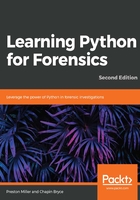
Variables
We can assign values to variables using the data types we just covered. By assigning values to variables, we can refer to that value, which could be a large 100-element list, by its variable name. This not only saves the programmer from re-typing out the value over and over again, but helps enhance the readability of the code and allows us to change the values of a variable over time. Throughout this chapter, we have already assigned objects to variables using the = sign. Variable names can technically be anything, although we recommend the following guidelines:
- Variable names should be short and descriptive of the stored content or purpose.
- Begin with a letter or underscore.
- Constant variables should be denoted by capitalized words.
- Dynamic variables should be lowercase words separated by underscores.
- Never be one of the following or any Python-reserved name: input, output, tmp, temp, in, for, next, file, True, False, None, str, int, list.
- Never include a space in a variable name. Python thinks two variables are being defined and will raise a syntax error. Use underscores to separate words.
Generally, programmers use memorable and descriptive names that indicate the data they hold. For example, in a script that prompts for the phone number of the user, the variable should be phone_number, which clearly indicates the purpose and contents of this variable. Another popular naming style is CamelCase, where every word is capitalized. This naming convention is often used in conjunction with class names (more on those later in this book).
A variable assignment allows the value to be modified as the script runs. The general rule of thumb is to assign a value to a variable if it will be used again. Let's practice by creating variables and assigning them data types we have just learned about. While this is simple, we recommend following along in the interactive prompt to get in the habit of assigning variables. In the first example here, we assign a string to a variable before printing the variable:
>>> print(hello_world)
Hello World!
The second example introduces some new operators. First, we assign the integer, 5, to the variable, our_number. Then, we use the plus-gets (+=) as a built-in shorthand for our_number = our_number + 20. In addition to plus-gets, there is minus-gets (-=), multiply-gets (*=), and divide-gets (/=):
>>> our_number = 5
>>> our_number += 20
>>> print(our_number)
25
In the following code block, we assign a series of variables before printing them. The data types used for our variables are string, integer, float, list, and Boolean, respectively:
>>> BOOK_TITLE = 'Learning Python for Forensics'
>>> edition = 2
>>> python2_version = 2.7.15
>>> python3_version = 3.7.1
>>> AUTHOR_NAMES = ['Preston Miller', 'Chapin Bryce']
>>> is_written_in_english = True
>>> print(BOOK_TITLE)
'Learning Python for Forensics'
>>> print(AUTHOR_NAMES)
['Preston Miller', 'Chapin Bryce']
>>> print(edition)
1
>>> print(python2_version)
2.7.15
>>> print(is_written_in_english)
True
Notice the BOOK_TITLE and AUTHOR_NAMES variables. When a variable is static, for instance, non-changing throughout the execution of a script, it is referred to as a constant variable. Unlike other programming languages, there is not a built-in method for protecting constants from being overwritten, so we use naming conventions to assist in reminding us not to replace the value. While some variables such as the edition of the book, language, or version of Python might change, the title and authors should be constants (we hope). If there is ever confusion when it comes to naming and styling conventions in Python, try running the following statement in an interpreter:
>>> import this
As we saw previously, we can use the split() method on a string to convert it into a list. We can also convert a list into a string using the join() method. This method follows a string containing the desired common denominator and the list as its only argument. In the following example, we are taking list containing two strings and joining them into one string, where the elements are separated by a comma:
>>> print(', '.join(["Hello", "World!"]))
Hello, World!